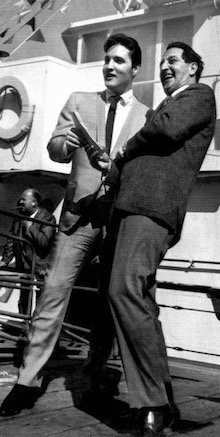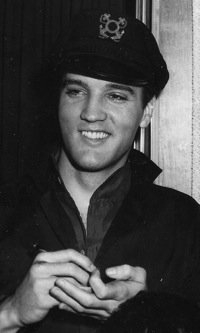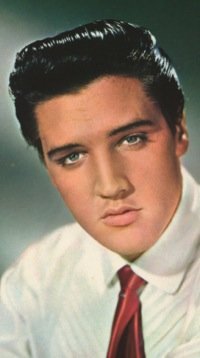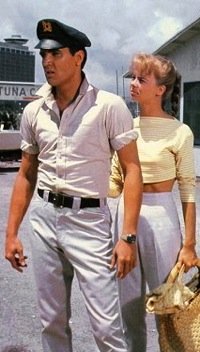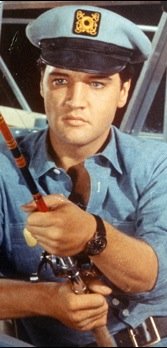Elvis History Blog
The USS Potomac
Elvis Presley's Gift to St. Jude Hospital
The afternoon of February 14, 1964, Elvis Presley performed one of the more publicized of his many charitable acts during his career. On that sunny Valentine’s Day in Long Beach, California, he deeded over the Potomac, President Franklin Roosevelt’s presidential yacht, to St. Jude Children’s Research Hospital. Accepting the donation was fellow entertainer Danny Thomas, who had founded the Memphis based hospital two years earlier.
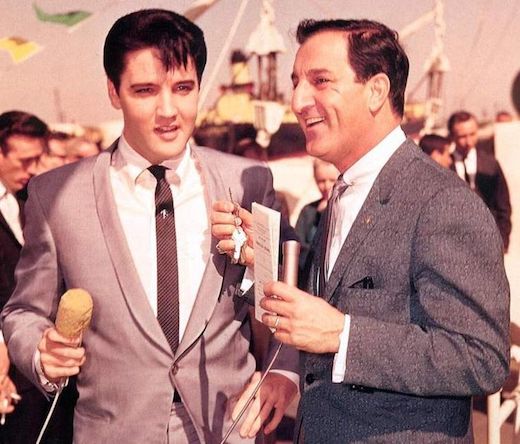
Unlike most of Presley’s altruistic deeds, this one was a prearranged public event. When Elvis arrived by car at the dock in Long Beach, he was swarmed by fans who had been forewarned of his coming by the press. Major Los Angeles newspapers sent photographers to cover the event. A large sign on the vessel’s upper deck read, “Presentation at 1 p.m. Today by Elvis Presley of the ‘Yacht Potomac’ to Danny Thomas in behalf of Saint Jude Hospital, Memphis Tenn.” After Presley, smartly dressed in a gray suit, handed Thomas the yacht’s keys and deed, the two men climbed the gangplank to the ship’s deck for a look around.
“It doesn’t surprise me that Elvis Presley is making this gracious contribution,” Thomas said after the ceremony. “Elvis is a great humanitarian.”
That day was the only time Elvis ever saw the historic vessel that he owned for just two weeks. On January 30, 1964, Colonel Parker purchased the Potomac at auction in Elvis’s name for $55,000. Parker had two goals in mind for his client when he made the unusual purchase—tax benefits and publicity. His initial plan was to donate the historic ship to the March of Dimes Foundation, long one of Elvis’ favorite charities, but the foundation told the Memphis Commercial-Appeal it declined the donation because they “did not think it proper to spend donated funds to maintain such a gift.”
Parker then offered the Potomac to a Miami Coast Guard Auxiliary unit. Again, though, the gift was not accepted. “The Miami group wanted to accept the yacht, sell if for scrap, and use the money to build a club house," a Coast Guard spokesman explained in the Commercial-Appeal. “This would be ranging pretty far from water safety and other purposes of an auxiliary unit so permission to accept the gift was refused.”
Then a North Carolina “promotion group” inquired about purchasing the Potomac as a companion vessel to put along side the battleship North Carolina, then on display as a war memorial in Wilmington. As that would have involved the unforeseen expense of sailing the yacht to the east coast and the chance of it breaking down along the way, Parker continued looking for a charity that would take it off his hands where it was in Long Beach. He offered it then to the new children’s hospital in Memphis, and, no doubt to Colonel Parker’s great relief, St. Jude took possession of the troublesome yacht.
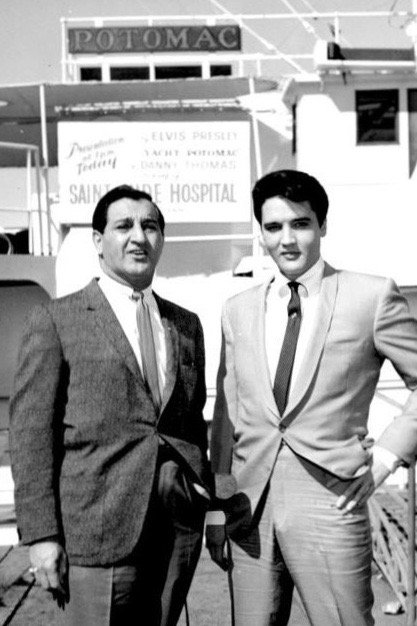
Elvis Presley was close by when Colonel Parker summoned him to the transfer ceremony on February 14. Vacationing in Las Vegas at the time, Elvis and a few of his sidekicks drove to Long Beach that morning. The Beatles had made their tumultuous first appearance on The Ed Sullivan Show just five days earlier, and Parker saw the Long Beach ceremony as an opportunity to put Elvis back in the news, if only for one day.
While it only took Elvis a few hours to reach the dock at Long Beach, it took the Potomac 30 years to get there. The ship came into the world about the same time Elvis Presley did. The Mantiowoc Ship Building Company in Wisconsin built the Icarus class cutter, originally named the Electra, in 1934. Commissioned in the Coast Guard the same year, the ship was 165 feet long with a beam width of 25 ¼ feet. At a cruising speed of 10 knots, its diesel engines consumed 300 gallons of fuel per 24 hours of operation.
In 1936 the Electra was transferred to the US Navy, renamed the USS Potomac, and reconfigured to serve as Franklin D. Roosevelt’s presidential yacht. Until his death in 1945, FDR used the vessel for meetings with US government officials and foreign dignitaries, as well as for recreational fishing trips. The ship served the state of Maryland until 1960, when it was sold for private use as a ferryboat between Puerto Rico and the Virgin Islands. In 1962 Hydro Capital company acquired the Potomac, invested $250,000 in refitting it, and sailed it from Barbados to Los Angles. When it was put on display at the King Harbor Marina in Redondo Beach, its machinery and interiors were in “first class condition,” according to Hydro president Glen Roland. By August 1963, over 14,000 people had toured the former presidential yacht.
Then things started to go wrong for the Potomac, as explained in a Memphis Press Scimitar article:
“The surf was bad during that period and the ship was in danger of being damaged by the surf breaking over the breakwater. With the full approval of the harbor master, the ship was moved out in the harbor and anchored. The insurance carrier found out the boat had been moved and said it could not cover the ship while it was swinging on its own anchor. Hydro Capital decided to get rid of the ship when it couldn’t find a suitable location.”
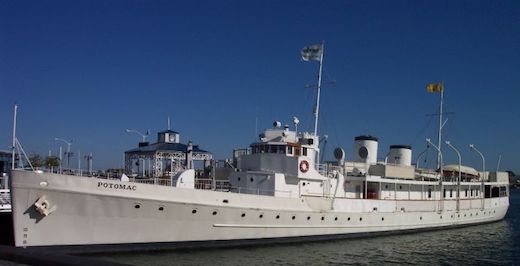
That’s when Colonel Parker stepped up to get the Potomac at auction for what seemed like a bargain bid of $55,000. Unfortunately, Parker’s intention to donate the ship immediately to a charity in Elvis’s name resulted in the former presidential yacht becoming the object of a ping pong game.
After receiving the deed from Elvis, St. Jude’s board of directors originally discussed moving the Potomac to Memphis and putting it on display at the end of a boardwalk on the Mississippi River. As St. Jude’s chief benefactor, though, Danny Thomas declared, “St. Jude is in the hospital business, not the boat business. It will probably be sold as scrap.” In that event, St. Jude’s financial gain from Presley’s gift probably would have been less than Elvis paid for it.
Fortunately for the Potomac and its historical significance, just a month after Thomas received the yacht, he was able to play the ping pong ball back across the table to a Beverly Hills attorney for $62,500. Kenneth “Red” Tressler told the Los Angeles Times he planned “to put a crew aboard the yacht and have it travel anywhere and everywhere so it can be seen by school children.”
Unfortunately, though, in 1980 the US Customs Service seized the Potomac after it was involved in drug smuggling. The Feds towed the ship to Treasure Island in San Francisco Bay and ignominiously sank her there. Fortunately, that was not the end of the line for the Potomac. After the Port of Oakland offered $15,000 for her as is, the US Navy refloated her. The newly formed Potomac Association raised $5 million for a full restoration over a 12-year period. In the summer of 1995, President Roosevelt’s “Floating White House” opened to the public at her berth off Jack London Square in Oakland. Since then, more than 250,000 people have boarded her for a cruise around the bay.
The Potomac faces another challenge these days, however. The Coast Guard has mandated dry docking maintenance for her, and the Potomac Association must raise enough money to pay for the expensive overhaul. Elvis fans who would like to contribute to preserving this historic ship as a living tribute to Elvis Presley’s charitable spirit can do so on the Potomac Association’s website. — Alan Hanson | © February 2017
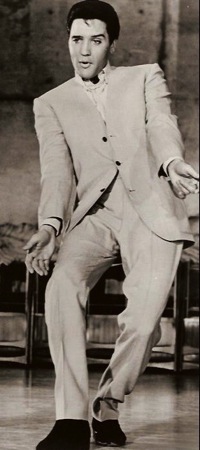
"Unlike most of Presley’s altruistic deeds, this one was a prearranged public event. When Elvis arrived by car at the dock in Long Beach, he was swarmed by fans who had been forewarned of his coming by the press."
